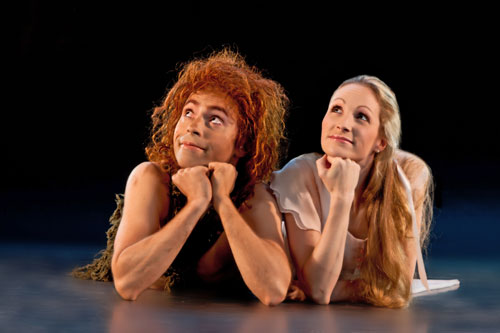Being Wendy

Houston Ballet artists Ilya Kozadayev and Sara Webb in Trey McIntyre’s Peter Pan.
Photo by Amitava Sarkar.
Sara Webb Revisits Peter Pan
Houston Ballet principal Sara Webb holds the coveted spot of Wendy in Trey McIntyre’s Peter Pan, a role she will revisit for the third time on June 13-23.
Webb first performed the role just one year into being a soloist. Although Webb’s career was nurtured by Ben Stevenson, she became the first soloist promoted by Stanton Welch just after he took the helm in 2003. Webb spoke with A + C editor Nancy Wozny about motherhood, dancing Wendy and McIntyre’s magical ballet.
Arts + Culture: What’s it like to revisit a role that you did much earlier in your career — before Stanton Welch, before children, before being a principal?
Sara Webb: Coming back to Peter Pan after all these years is surreal on so many levels for me. The first thought I had when I heard we were performing this ballet again was, “I can’t wait for my children to see this!” And the second thought was, “Will I still be able to be true to the youthfulness of Wendy’s character after all these years?”
Returning to the role of Wendy now, after being a Principal for almost 10 years and having two children of my own, has been a completely different experience. The steps are the same and so is the story, but my approach comes from a place of experience and a better understanding of who Wendy is, and how she became that person.
A + C: What has going on for you then in your career?
SW: When Trey choreographed Peter Pan, I was a newly-promoted soloist in the Company and just starting to “grow” in my career. Wendy was such a wonderful role to start with. Wendy changes from a girl to a woman during the ballet, and, in a way, so did I. Up to that point, I had performed many of the “little girl” roles: Clara in The Nutcracker and Swanhilda in Coppelia, which I loved. But I will never forget Lauren Anderson helping me the next time I did Sugarplum by showing me how to dance the role more like a woman, rather than a young girl. With the help of Lauren and many others, I started to become more “grown up” in my dancing.
A + C: Does dancing this ballet bring you back to an earlier time at Houston Ballet?
SW: It does take me back to the time we set the ballet with the original cast, and the process we went through in helping Trey to create this ballet. I think about where all of those people are now; How wonderful to see how everyone has “grown up” and what amazing adventures they have had, and continue to have!
A + C: What’s unique about McIntyre’s ballet?
SW: Trey did such an amazing job bringing this timeless story to life on stage. I appreciate that he stayed true to J.M Barrie’s narrative and yet, at the same time, included his own interpretation and twists. I love to hear the audience gasp when Peter teaches the Darling children how to fly for the first time. Stars pour out into the audience, as if Tink sprinkled them with pixie dust herself and helped them find their happy thoughts.
I also love that this ballet truly is for everyone, young and old alike, because we can all relate to it in some way. We are all at different stages of “growing up” and no matter where that might be for you, Peter will be sure to find his way into your heart again.
A + C: How do you look at Peter Pannow that you are a mother and very close to the magical properties of childhood?
SW: I used to view Peter as just a character whom Wendy loved because he took her on fun adventures and made her happy. I also considered the ballet to be a bit tragic — the death of childhood, as Wendy decides to grow up and gives up being a child. Often in rehearsals, dancers — especially ones seeing the ballet for the first time — will comment on how sad the ending seems. I used to agree with them and thought it was too bad that “all children, except one, grow up.”
Now, looking at Peter with a mother’s eyes, I see him more as a representation of childhood itself. At the end of the ballet, when Wendy says goodbye to Peter, she is not really saying goodbye to the character, but is putting childhood away in her heart. What I didn’t understand then was that, when Wendy holds her child at the end of the ballet, she begins a whole new chapter of wonder and fun. Now I know what an incredible adventure it is to be a mother.
I also look at the story through the eyes of Wendy’s parents now, knowing that my young children will have to grow up someday. I am already starting to see that with my 5-year old son, who I think of as my own little Peter Pan. The words of Mrs. Darling come to mind often, “Oh, why can’t you remain like this forever?” But as an adult I have learned that the beauty of keeping Peter in our hearts means that the wonderment and happiness of our childhood can always be with us, ready to be enjoyed through our memories and our own children.
In fact, I can’t decide which I want to do more: have my children watch me dance Wendy or watch it with them and see their reactions the first time they see it. Maybe I’ll do both.




Recent Comments